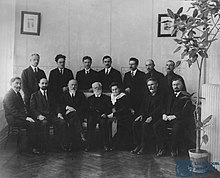Paul Olberg
Appearance

Paul Olberg (born: Hirsch Schmuschkowitz, 22 November 1878 – 4 May 1960) was a Latvian-born German-Swedish journalist and a Menshevik. In 1917, after the October Revolution, went into exile in Berlin, where he lived for many years. He worked as a correspondent for Swedish social democratic newspapers. In 1933, he fled to Stockholm; that year, he became Secretary of the Stockholm-based Socialist Rescue Committee for German Refugees.

In the first row: S. Devdariani, Noe Ramishvili, Noe Zhordania, Karl Kautsky and his wife Luise, Silibistro Jibladze, Razhden Arsenidze;
in the second row: Kautsky's secretary Olberg, Victor Tevzaia, K. Gvarjaladze, Konstantine Sabakhtarashvili, S. Tevzadze, Avtandil Urushadze, R. Tsintsabadze
Olberg was Scandinavian representative of the Jewish Labor Committee, and headed the JLC's Stockholm office; from 1945, he coordinated the JLC's postwar services to refugees in Scandinavia.
In 1957 Olberg was a member of the coordinating committee of the International Jewish Labor Bund.[1]
Bibliography
[edit]- Briefe aus Sowjet-Russland, 1919
- Die Bauernrevolution in Russland: Die alte und die neue Politik Sowjet-Russlands, 1922
- Die Tragödie des Baltikums: Die Annexion der freien Republiken Estland, Lettland und Litauen, 1941
- Det moderna Egypten i det andra världskriget, Natur & Kultur, 1943
- Antisemitism i Sovjet, Natur & Kultur, 1953
Further reading
[edit]- Blomqvist, Håkan (2014). "Lost Worlds of Labour: Paul Olberg, the Jewish Labour Bund, and Menshevik Socialism". In Götz, Norbert (ed.). The Sea of Identities: A Century of Baltic and East European Experiences with Nationality, Class, and Gender (PDF). Södertörn academic studies, 60. Huddinge: Södertörn University. pp. 139–172. ISBN 978-91-87843-00-6. ISSN 1650-433X.
- Enerud, Per (2017). Den farligaste av flyktingar: Paul Olberg – antinazist, antikommunist och dissident i folkhemmet (in Swedish). Stockholm: Carlssons. ISBN 978-91-7331-817-4.
References
[edit]- ^ Hertz, Jacob Sholem (1958). Unser Tsayṭ (ed.). Der Bund in bilder, 1897-1957 (in Yiddish and English). New York.
{{cite book}}: CS1 maint: location missing publisher (link)
